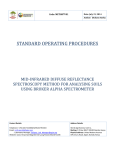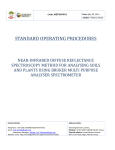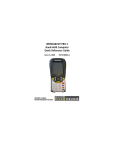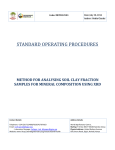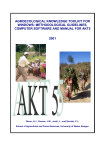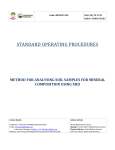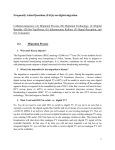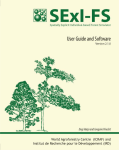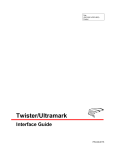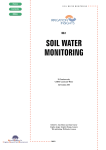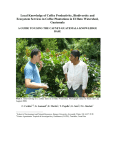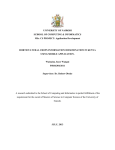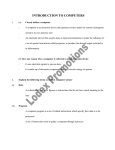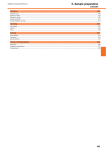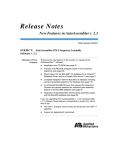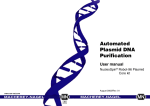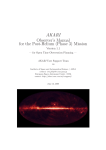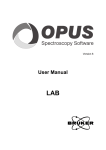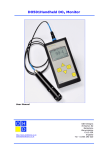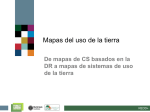Download STANDARD OPERATING PROCEDURES
Transcript
Date: July 30, 2014 Code: METH08V01 Author: Dickens Ateku STANDARD OPERATING PROCEDURES INFRARED DIFFUSE REFLECTANCE SPECTROSCOPY METHOD FOR ANALYSING SOILS AND PLANTS USING BRUKER TENSOR 27 HTS-XT SPECTROMETER Contact Details: Address Details: Telephone: +254 (20) 7224000/4235/4279/4163 Email: [email protected] : Laboratory Manager, [email protected] Website: www. http://worldagroforestry.org/research/land-health World Agroforestry Centre, Mailing: P.O Box 30677-00100 Nairobi, Kenya Physical address: United Nations Avenue Off Limuru Road, Gigiri, Nairobi, Kenya STANDARD OPERATING PROCEDURE Code: METH 08V01 Title: Method for analysing samples for spectral characteristics in Mid IR range using HTS-XT Date: July 30, 2014 Author: Dickens Ateku METHOD DOCUMENT CONTROL LOG Author(s) Verifiers Authorizer Name and position Dickens Ateku Alubaka -Senior Laboratory Technician Signature [signature for completeness and correctness of document] Dickens Ateku Alubaka -Senior Laboratory Technician [signature for completeness and correctness of document] Beatrice Mwangi -Laboratory Technician [signature for completeness and correctness of document] Elvis Weullow -Deputy Laboratory Manager [signature for completeness and correctness of document] Distribution of valid copies of this document: G 149 Infrared Spectroscopy Laboratory Revise before: Historical data Date retrieval: [date] [dates of previous issues] [to be filled in once the document has become obsolete and is archived] Changes in this version compared to previous version: [Describe what has changed in the text of this version compared to the previous version] SCOPE AND APPLICATION This is a World Agroforestry Centre’s Soil-Plant Spectral Diagnostic Laboratory SOP for analysis of soils and plants using near and mid IR spectra recorded with Tensor 27 HTS-XT module. The technique involves shinning of near or mid infrared light on the samples and capturing of the reflected light in to raw file known as the interferogram. The spectrum recorded bears the qualitative and quantitative chemical aspect of the sample for further use with various data processing systems. This SOP is applicable to those doing soil and plant analysis on infrared 2 |H T S - X T S O P STANDARD OPERATING PROCEDURE Code: METH 08V01 Title: Method for analysing samples for spectral characteristics in Mid IR range using HTS-XT Date: July 30, 2014 Author: Dickens Ateku laboratory using Tensor 27 HTS-XT spectrometer. The instrument uses the potassium bromide (KBr) beam splitter and the Bruker’s OPUS software. PRINCIPLE The Tensor 27 HTS-XT Module is designed for measurements in diffuse reflection. The optics of a diffuse reflection accessory is designed in such a way that detection of diffusely reflected light is optimized and the detection of specular reflected light is minimized. A DRIFT is an analyzing technique in FT-IR spectroscopy that makes use of the phenomenon of diffuse reflection. The key advantage of these techniques is that it enables analysis of strongly scattering and absorbing samples unlike transmission measurements and equally has high signal intensity. ABBREVIATIONS AND DEFINITIONS DRIFT –Diffuse Reflectance Fourier Transform spectroscopy. OPUS –Bruker’s Optical User Software SOP - standard operating procedures NIR –Near infra-red MIR – Mid infra-red STD – standard soil sample FTIR- Fourier Transform Infrared Spectroscopy RELATED DOCUMENT Tensor 27 Technical manual HTS-XT Technical manual Validation and Maintenance Technical Manual Sample Reception and Preparation SOP MIR Workflow Infrared Health and Safety SOP RELATED FORMS Login form 3 |H T S - X T S O P STANDARD OPERATING PROCEDURE Code: METH 08V01 Title: Method for analysing samples for spectral characteristics in Mid IR range using HTS-XT Date: July 30, 2014 Author: Dickens Ateku Recording sheet SAFETY AND ENVIRONMENT Electrical hazards: Electrical systems must conform to the ICRAF standards. No shock hazards exist inside the instruments. Do not try to repair the faulty electrical system but call for assistance from an authorized service representative or an individual with training in electronic repair. The instruments require a third-wire protective grounding conductor. Three-to-two wire adapters are unsafe for these instruments. Dewar vessel: one 25 liters Dewar vessel for carrying liquid nitrogen. Use gloves when topping up liquid nitrogen on the instrument. REQUIREMENTS Supplies a. Liquid Nitrogen b. 70% Ethanol (for cleaning the Aluminium sample holding cups) c. Ear buds (for cleaning the Aluminium sample holding cups) d. Tissues Equipment a. The High Throughput Screening Accessory (HTS-XT ) b. Pike Miracle Diamond Attenuated Total Reflectance Accessory (ATR) c. Transmission Accessory using KBr pellets or liquid sample cells d. Retsch motor grinder RM 200 Materials a. Aluminium sample holding plates b. Gold plate c. Micro spatula d. Non-fluffy cloth PROCEDURE Soil Sample preparation and loading 4 |H T S - X T S O P STANDARD OPERATING PROCEDURE Code: METH 08V01 Title: Method for analysing samples for spectral characteristics in Mid IR range using HTS-XT Date: July 30, 2014 Author: Dickens Ateku The loaded soil samples should be air-dried, sieved through a 2mm sieve, subsampled using the coning and quartering method and grinded to less than 0.5mm (fine powder particle size between 20- 53 µm) using RM 200 Restch motor grinder (Refer to the HTSXT Spectrometer Technical Manual). a. Collect about 10 g subsample from air-dried 2-mm sieved soils and minerals that are processed through SOP. Use coning and quartering method in case of large samples. (Refer to the Tensor 27 SOP page 13) b. Dry the 10 g subsample in an oven at 40°C for 24 hours c. Grind the sample using RM 200 Retsch motor grinder to a fine powder to attain a particle size between 20- 53 µm. d. Load the sample into aluminum sample plate by filling it with the fine ground soil. It takes about 1-2 g depending on the type of soil. (Refer to the Tensor 27 SOP page 13 and 14) e. Prepare a data sheet indicating sample IDs and sample position in the plate. Ensure that you enter the sample ID immediately after filling the wells of the plate. Plant Sample preparation and loading The loaded plant samples should be milled to pass through 0.5mm sieve using willey mill machine (Refer to the Sample Reception and Preparation SOP). a. Load the plant sample into aluminum sample plate by filling it with the fine milled plant. It takes about 1-2 g depending on the type of plant. (Refer to the Tensor 27 SOP) b. Prepare a data sheet indicating sample IDs and sample position in the plate. Ensure that you enter the sample ID immediately after filling the wells of the plate. Recording sample spectra using the OPUS a. Power up the instrument and log into the OPUS software (Technician must get himself/herself familiarized with operating instructions of the instrument by going 5 |H T S - X T S O P STANDARD OPERATING PROCEDURE Code: METH 08V01 Title: Method for analysing samples for spectral characteristics in Mid IR range using HTS-XT Date: July 30, 2014 Author: Dickens Ateku through the ICRAF soil and plant spectral diagnostic laboratory adopted version of user manual for Tensor 27 HTS-XT Module) b. Select the advance data collection option in OPUS and load the method as per the SOP (Refer to the Tensor 27 HTS-XT manual pages 17 to 32) depending on the experiment you want to run. Sample spectral measurements in the MIR range (4,000 -1 – 400 cm ) is done using the TENSOR 27 Spectrometer. This machine has three sampling accessories: The High Throughput Screening Accessory (HTS-XT), which is used for high throughput diffuse reflectance and transmission measurements. Pike Miracle Diamond Attenuated Total Reflectance (ATR) accessory for ATR measurements. Transmission accessory for Tensor 27, which can be used for transmission measurements using KBr pellets or liquid sample cells. We will only use this for instrument testing and Validation. c. Create a folder that identifies the batch of soils being analyzed on the computer connected to the instrument d. All spectra recorded on test samples should be saved in a separate folder. For example C:\ICRAF\RAW\SOTUBA SITE SOILS…………….for all Sotuba soils. e. Create a template of the number of plates you want to run and save it in a folder with a name for easy tracking (Refer to the HTS-XT manual on how to create the template). f. Place the standard gold reference plate inside the sample plate drawer and do a position test by clicking on the Opus, Validation menu and select Position test. Click ok to run it and remove the plate after finishing. g. Place an empty aluminum plate inside the sample plate drawer and do a signal check test and remove it after finishing. Amplitude of between 16,000 and 30,000 is good. h. For spectral measurements, aluminum plates whose micro-titer wells are full of the fine ground soil are loaded into the sampling drawer of HTS – XT manually or 6 |H T S - X T S O P STANDARD OPERATING PROCEDURE Code: METH 08V01 Title: Method for analysing samples for spectral characteristics in Mid IR range using HTS-XT Date: July 30, 2014 Author: Dickens Ateku automatically using the robotic arm. i. After loading the template you had created the robotic arm sequentially and automatically picks a loaded aluminum micro-titer plate into the HTS – XT drawer where the plates are scanned well by well. Upon completion of scanning the wells in a plate, the drawer opens; the robotic arm picks the plate and places it on the output tray, picks another plate and places it in the sampling drawer. (Refer to Tensor 27 manual page 16) QUALITY CONTROL Reference Material a. Reference standards: Infrared ICRAF laboratory uses Katumani, High Black Cracking Clay Soil (HBCCS), Mua soil and White sand as reference standards. Everyday a new spectrum is recorded on these samples before analyzing test samples and checked against the previous records. Appropriate correction actions where necessary are implemented. Normally no adjustments are required. b. Blanks: Two empty wells A1 used for background measurement and B1 used as a blank in each Aluminum plate loaded with sample. c. Calibration: No calibration is required. d. Duplicates: Two replicates are done for each sample. Data Validation a. Data Review Check the sample data and QC data to verify that the data to be reported is based on acceptable analyses and meet acceptable limits. Verify that Mua standard spectra have been entered into the appropriate logs. Verify that the results are saved in appropriate folder and format. Place data in the laboratory database. b. Supervisor Review Check the sample data and QC data to verify that the data to be reported is based on acceptable analyses and meet acceptable limits 7 |H T S - X T S O P STANDARD OPERATING PROCEDURE Code: METH 08V01 Title: Method for analysing samples for spectral characteristics in Mid IR range using HTS-XT Date: July 30, 2014 Author: Dickens Ateku If any errors are found, return data for repeat analysis. REFERENCES TENSOR 27 User’s Manual, 1ST Edition, BRUKER OPTICS GmbH, 2002, page 1–page 44 HTS-XT User Manual, 1st Updated Edition 121872, BRUKER OPTICS GmbH, June 2005, page 1 –page 42 Bruker Tensor 27 FT-IR & OPUS Data Collection Program (V 1.1) , BRUKER OPTICS GmbH, page 1 –page 47 Twister User’s Guide, Zymark Corporation, page 1 –page 80 ANNEX 1. Work Flow 8 |H T S - X T S O P Date: July 30, 2014 STANDARD OPERATING PROCEDURE Code: METH 08V01 Title: Method for analysing samples for spectral characteristics in Mid IR range using HTS-XT Author: Dickens Ateku This laboratory uses infra red rays to analyze samples Infra-red Laboratory Workflow Objective: To provide fast high through put, cheap and accurate analysis (optimization of analysis) (TENSOR &ALPHA) LEGEND Preparation From Preparation Factory Action point Decision point All the processes for sample preparation are outlined in the sample preparation workflow and SOP Tape notes Stored data alpha Process route Instrument? Tensor 27 ALPHA TENSOR 27 There are two ALPHA FTIR instruments: KBr and ZnSe ATR Module? *KBr DRIFT Module? *ATR Mix sample with KBr then make a tablet It has a Zinc Selenide cystal Uses MIR mode and its best suited for very tiny samples and it has a diamond crystal HTS-XT · · · Samples Scanning Load Method For ATR pour sample directly on the ATR crystal using a micro spatula For the DRIFT place the sample cup on sample holder Reflectance Mid Infra-Red Load Method? Reflectance Near Infra-Red Transmission Method* Samples Scanning · Data Process All the data processes are illustrated in the SOP · Samples loaded on aluminum plates are scanned on either the NIR mode or the MIR mode For transmission mode, samples are loaded on silica plates To Database ATR - Attenuated Total Reflectance DRIFT - Diffuse Reflectance KBr – Potassium Bromide 2. Infrared ALHPA spectrometer standards fact sheets 9 |H T S - X T S O P * Method not frequently used STANDARD OPERATING PROCEDURE Code: METH 08V01 Title: Method for analysing samples for spectral characteristics in Mid IR range using HTS-XT Date: July 30, 2014 Author: Dickens Ateku Tensor 27 HTS-XT Instrument calibration standards These are standards used for all analysis in the ICRAF Soil-Plant diagnostic laboratory. Heavy black cracking clay soils (HBCCS), Katumani, and MUA standards are run every day in the morning before you start any analysis and every time you start on a new site. White sand a commercial Standard which is run every day in the morning before you start any analysis and every time you start on a new site. 3. Quality Control fact sheet PROCESS DESCRIPTION Background Measurement The instrument is set in a way that it performs background measurement before scanning each well. The measurement normally increases the signal to noise ratio of the spectrum produced (improves the quality of the spectra) Measurement of the selected soil standards. The standards used in ICRAF infrared laboratory are HBCCS, Katumani, MUA and White Sand. The measured spectra are used to monitor the performance of the instrument. Check on the quality of the spectrum measured Always monitor the instrument moisture. Ensure that the spectrum measured does not have any noise due to moisture and carbon dioxide. The moisture noise peaks are expected at around 3600cm and 1600cm wave numbers while the carbon dioxide peak is expected at around 2400cm wave numbers. 10 |H T S - X T S O P STANDARD OPERATING PROCEDURE Code: METH 08V01 Title: Method for analysing samples for spectral characteristics in Mid IR range using HTS-XT 11 |H T S - X T S O P Date: July 30, 2014 Author: Dickens Ateku











